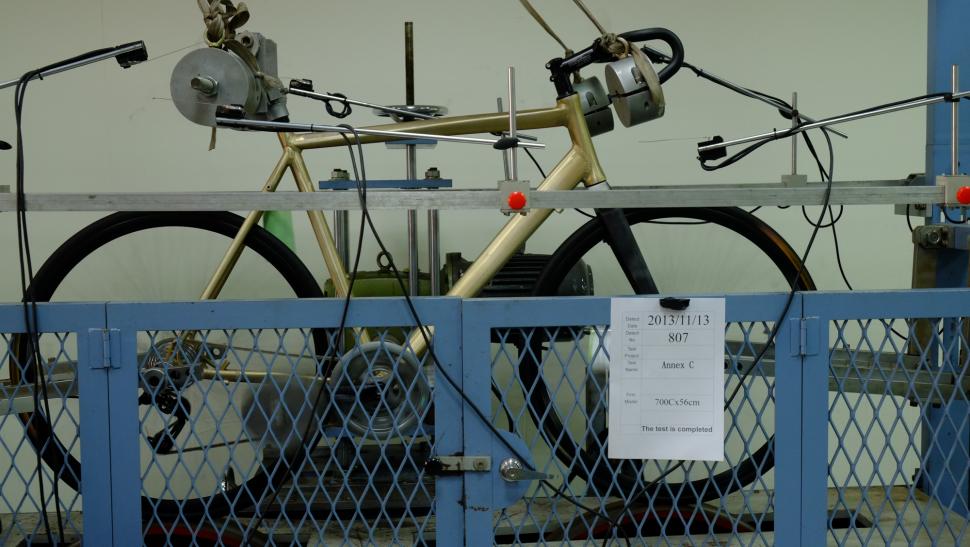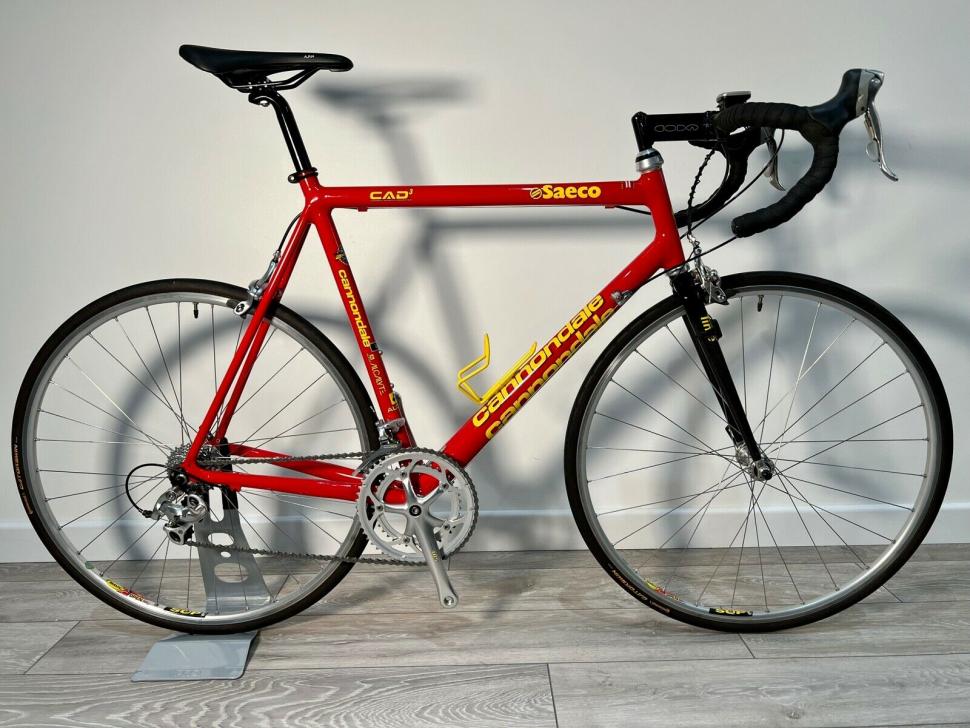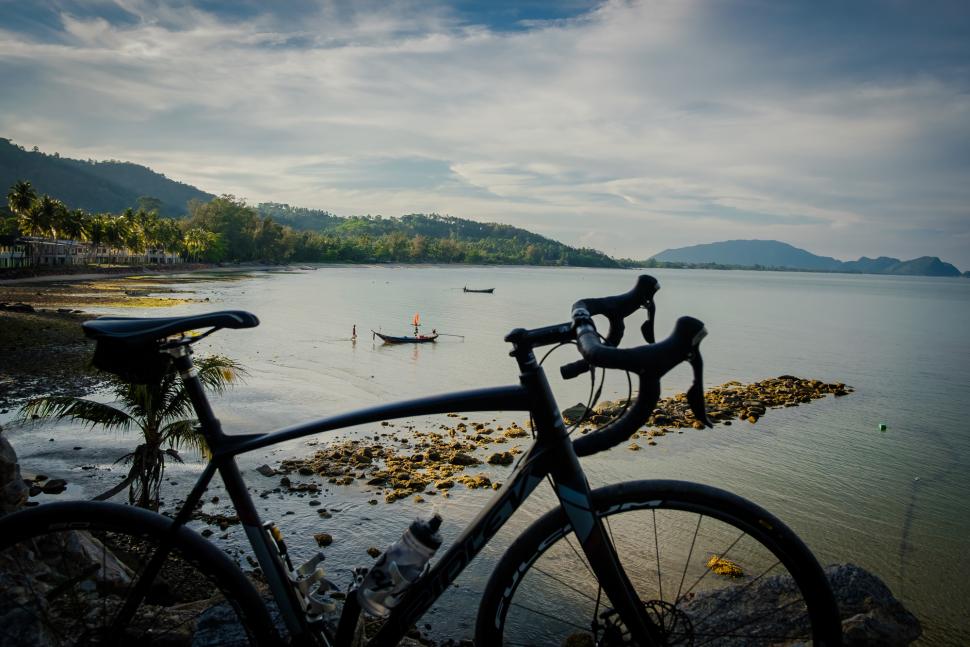- News
- Reviews
- Bikes
- Accessories
- Accessories - misc
- Computer mounts
- Bags
- Bar ends
- Bike bags & cases
- Bottle cages
- Bottles
- Cameras
- Car racks
- Child seats
- Computers
- Glasses
- GPS units
- Helmets
- Lights - front
- Lights - rear
- Lights - sets
- Locks
- Mirrors
- Mudguards
- Racks
- Pumps & CO2 inflators
- Puncture kits
- Reflectives
- Smart watches
- Stands and racks
- Trailers
- Clothing
- Components
- Bar tape & grips
- Bottom brackets
- Brake & gear cables
- Brake & STI levers
- Brake pads & spares
- Brakes
- Cassettes & freewheels
- Chains
- Chainsets & chainrings
- Derailleurs - front
- Derailleurs - rear
- Forks
- Gear levers & shifters
- Groupsets
- Handlebars & extensions
- Headsets
- Hubs
- Inner tubes
- Pedals
- Quick releases & skewers
- Saddles
- Seatposts
- Stems
- Wheels
- Tyres
- Health, fitness and nutrition
- Tools and workshop
- Miscellaneous
- Tubeless valves
- Buyers Guides
- Features
- Forum
- Recommends
- Podcast
OPINION
Aluminium frames are the work of the devil
 Aluminium bike stress testing - credit Steve Thomas
Aluminium bike stress testing - credit Steve ThomasMine may well have become vaguely lost in the great mist of time, but those distant memories, the harsh realisations and promises that I made to myself many years ago have come trickling back to haunt me in recent months... namely where I said I would never ride another aluminium bike frame.
> 10 of the best British bike brands of the '70s and '80s
First things first: before all the love for this great Coke can-like material comes flooding in down in the comments section, please do note that this is an opinion piece. It's based off my own many decades of experience riding bikes made from everything from bamboo to magnesium, with a whole heap of steel, titanium and aluminium thrown into the mix... oh and of course, some metal matrix too. These are my own groans aches and opinions, and I don't expect everyone to agree!
The pre-AL era
When I started riding and racing bikes in the '70s it was about steel, all about steel. From the forks right through it was all that good old hard stuff. There weren't really any other viable frame material options back then.
Sure enough the different tubing grades and builds did make for very different rides between the various combinations available, and mostly they were of the slightly forgiving kind. Thankfully in recent times there is some form of appreciation for steel coming back, and maybe even those younger riders who’ve never slung a leg over a quality steel horse will one day try one and find out why us old fellas love them so much (or at least some of us still do), even if they have drifted out of vogue.
> Southern Steel: take a trip down memory lane with these classic 20th century bike builders
Material world order
Perhaps I was lucky that I went from riding steel straight to various forms of titanium frames, and then to carbon fibre – lucky as in there were only a few fleeting encounters with the bone shacking and wrist jarring frights without the delights of aluminium bikes. Even then those that I did ride were mostly fat-tubed mountain bikes, where much of that harshness was padded out with big tyres, suspension, cross-laced wheels and slack angles.
I did have a couple of reasonable aluminium road frames back around the turn of the century, but even then I found them to be super harsh on the lower back and my wrists, which were rattled to popping point after years of pre-suspension mountain biking.
Back then, aluminium had become the de rigeur material of choice for frame building, mostly because it was so cheap and easy to get hold of and mass produce in the Far East... and yep, just about all of the major pro road teams did ride aluminium bikes for a while, although their rides were generally tempered a little by carbon forks.
Even so, many of those frames were still very harsh in my opinion, albeit that they were compliantly rigid. For me they were just too rough and not quite ready, although perhaps my opinion would be different had I been groomed on aluminium from the start.
At around about that same time, Cipollini et al were all racing around on those gorgeous, bold Cannondales. Cipo made fat aluminium look like sex on two wheels, and so when I was offered a good price for one as an end of line clear out (by friends with a bike shop) of course I jumped at the chance.
It was a dull and dark blue in colour, and so I managed to get friends in the bike industry to spray it up in bright sparkling green. I built it up with all clean and polished Campagnolo kit, and garnished it with highly polished stem and bars. It did look the dog, even with those eyesore extended rear stays.
It didn’t take long for me to start loathing the harshness of that ride, and then the lower back troubles, shoulder and wrist ache became a regular thing. It was not a bike that I could ride for hours on end, and as much as I loved the looks of that green Hulk-like beast, it just had to go.
For a while I did get through a couple more aluminium frames, things just panned out that way. One was of the same stiff ilk and was promptly sold, the other (a Diamondback) was slightly easier on the spine, but was so flimsy that on its very first outing to Mallorca, the down tube took a huge ding in the bike bag, and so it still lingers in the back of a shed somewhere.
Grand designs?
At that time I wasn’t wholly sure whether that hard ride was partly down to the frame design (the rear stays), or whether it was simply that aluminium really had not gotten much easier on my ageing body, so I decided not to compromise again on an aluminium road bike.
As luck would have it I did get hold of a couple of titanium frames just after this: a Merlin XLC compact road frame, and a Litespeed Blue Ridge 'touring' frame. This duo added a whole new level of plushness to my ride immediately, and one that had most definitely made me a titanium frame fan boy.
Times have moved on, and I’ve shifted continents. Those titanium bikes are still around and almost as sweet as ever but, just about everything from the carbon forks to the groupsets are worn out, and being based in part of Asia where anything but pure race bikes and kit are an issue to find, and where someone six foot tall is considered to be a yeti, it’s hard to get hold of viable alternatives.
I have a couple of carbon road frames around, but they don’t really suit the riding I mostly do these days: hot and rough roads (and gravel), often with climbs that make the Bwylch y Groes seem like a mill pond.
Still shaken, and stirred
This is where the evil aluminium sneaked back into my life, just like that proverbial crazy ex from hell. On a trip to the USA I managed to mail order an aluminium gravel bike of Belgian origin. Before I’d even finished assembling it I knew it was potentially a beast of back-breaking burden, and sure enough I was soon shown to be right.
I did consider selling it almost immediately, as the discomfort was just too much for me; however, there was no way of me getting an alternative, and so I’ve stuck with it... on and off that is.
Just over a year ago I did take a trip to another region with this bike (it was the only fully functioning option at the time), which was when the wrath of the second wave of the pandemic struck, leaving me stranded with nothing but this bike for company ever since.
As much as I’ve swapped out the wheels, widened the tyres and softened the saddle, it just doesn’t cut it for me in the comfort department. Okay it is a gravel bike, but the ride is so harsh that I’ve almost 90% switched to riding it on the roads now.
My back, my ribs, my shoulders and my neck have taken such a pounding in the last year, which takes me right back to the sensation of that early Cannondale. Aluminium truly is the work of Satan Cycles Inc, at least as far as I’m concerned! Sure there are those younger riders out there who can ride on razor blades, and who have never known any different. But, one day, they most probably will.
For me, as I scour and search for ways of turning aluminium into something more rideable, I do have to remind myself not to fall into the trap of buying more of the stuff simply because it’s all I can get hold of. For now I’ll stick mostly to the hard stuff and soften the tyre pressure some more, just until I can find a ride less brutal on my old body...
More Opinion
Latest Comments
- Rendel Harris 4 sec ago
Care to comment on the fact that according to Mr.O'Connell and an external road safety company's data there have only been three cyclist Personal...
- Hirsute 21 min 4 sec ago
He's just a pathetic troll. Please ignore.
- slc 1 hour 2 min ago
Some locals (apart from road.cc regulars) like the scheme. Admittedly in the Beaufort Rd section where the carrot (end of what was pretty...
- S.E. 15 hours 7 min ago
My guess is that they sell mainly on the German market - feel free to correct me. That might explain why they are not "pushing" their products,...
- ktache 15 hours 32 min ago
Now Emily Chappell really liked the Lezyne , I have the HV version, good, but I find the handle uncomfortable in use. I've often wondered about the...
- biking59boomer 14 hours 39 min ago
What about this one!? Taken in Cardiff Civic Centre 1939
- Muddy Ford 15 hours 42 min ago
Charlie Alliston got 18mths and is the reference case (because there are so few cases) for all campaigns by anti-cyclists that 'cyclists are not...
- belugabob 16 hours 44 min ago
My local football practice pitches (all weather, in a fenced off area, are regularly the scene of inconsiderate parking, with vehicles blocking the...
- Spangly Shiny 17 hours 9 min ago
Assos ASOS anyone?
- chrisonabike 17 hours 22 min ago
Replace them all with Bromptons and they'd take up zero space within days or even hours, as they are all relocated elsewhere. To eBay or possibly...



Add new comment
116 comments
Your attempted point was that manufacturers commonly use CF for forks and seat posts. I explained exactly why. Or, more precisely, one of the reasons why. CF is also cheaper than titanium, and lighter than other options. To say nothing of marketing. Manufacturers of many products use materials without any benefit, if customers will pay a premium for them.
Your second attempted point was that you preferred one of your frames over the other -- and again, I explained to you why.
I'm afraid you are going to have to try again.
You didn't explain anything that was vaild - as mentioned previously - it's not about frame flex.
Anyway - Just for reference we have tyres here and we spend pounds.
Really. So you are claiming that it is "invalid" to state that CF is lighter than other frame and fork material options? And it's "invalid" to point out that bike manufacturers often have completely non-technical motivations for selecting materials?
Or, more to the point, that frames are a different shape than posts and forks.
I'm afraid you are going to have to try again.
So if you've finally abandoned the idea of frame flex, what is it now about? Please say 'vibration damping'. I am dying to hear how and why frame builders use some magical formulations of CF and titanium that are apparently unavailable to fork, post, saddle, stem, and handlebar manufacturers. Also cannot wait to hear about these bottom bracket and headset bearings that transmit every vibration with audiophile fidelity.
A significant proportion of which can be accounted for with the groupset so as I stated - your argument is nonsense and also clearly completely misses the point.
But hey - keep going Alu fanboy!
How much do you think the cost difference was between 105 and Ultegra at the OEM prices of the day?
I don't think you realise how moronic this sounds.
Significantly less moronic than refusing to accept the blindingly obvious.
So blindingly obvious that the comments are full of people who disagree with you.
Well - there are a few comments from your fellow alu fan boys but nothing that remotely approaches a worthwhile counter argument - how about (attempting) to answer my question?
So blindingly obvious that the comments are full of people who disagree with you
I think it's a futile and thankless task trading sense with a nutter peddling a load of nonsense blended with stupid epithets like 'alu fanboy'. Apparently, I'm one of these, despite having never owned a single aluminium framed road bike (I do have an oversized tubing Al mountain bike). I'm getting used to this- I'm also designated as a dimwit unable to perceive that disk brakes are really rubbish, having been deceived by marketing into a belief that they're a lot better (for non-racers) than rim brakes and that those rims that I thought I had worn through from braking were merely an illusion. There are quite a few stupid people on here.
Why is it difficult for you to accept the real life experience of someone who has tested it out? As I mentioned - I LOVE both bikes and have had them for years.
If you haven't got any actual experience yourself you are simply peddling a load of nonsense you've read on the web.
It's worse than that - the disc brakes you like are - shudder - MECHANICAL.
Most comfortable bikes I've ever ridden: Mason Definition (Al), Kinesis T3 (Al), Bianchi Infinito (carbon), Cervelo R5 (carbon)
Least comfortable bikes I've ever ridden: Felt FA (Al), Cervelo S3 (carbon), Genesis Day One (steel), Van Nicholas Ventus (Ti)
The Genesis and Van Nic were particularly harsh, despite steel and titanium allegedly providing a "magic carpet" ride.
I don't think frame material makes a blind bit of difference to ride quality. Geometry, tube selection, wheels and tyres, however...
I had a Scott Aluminium bike and it was the biggest POS but it got me back into riding. I decided if this was Aluminium my next bike would be carbon. Forward a few years and did a holiday where I rented a caad12 because it was the same as my Evo at home but cheap to rent. It was brilliant and so close to the Evo I bought one when I got home as a winter bike. I've just killed it by ripping off the braze on! She will be missed. Wheels do make a big difference even the same tyre/tube combo. Recently gone tubeless and 28mm on a bone shaking aero bike and honestly has turned it into an all dayer.
My aluminium specialized secteur was the most comfortable bike I've ever ridden (25mm tyres). Going from that to a steel genesis day one was so bad I thought something was broken. My next bike was a carbon canyon - probably on par with specialized. Now I'm back on steel (fairlight) and that's probably the best, but not by much. Sounds like you've had very bad luck with aluminium frames! (Or I've had very good luck).
I've only ridden steel, aluminium and carbon fibre, but I don't really believe that the frame material makes that much difference to the ride compared to tyre pressure. Is it a placebo effect?
I'd argue that wheels are equally, if not more important. I built a Ti Litespeed with Ksyrium SLs that made my lower back numb. In desperation I switched in some wheels from my touring bike and it rode like a magic carpet. Still ride it more or less daily 20 years later, though now it has some BlackInc carbon wheels from my cannibalised Factor.
I don't believe in wheels providing much suspension apart from the tyres. Surely a mm or two compliance in a wheel is dwarfed by the tyres unless they're super hard.
Funnily enough, I was thinking the same about tyre pressure - especially on old alloy frames with insufficient space for modern wheels and 25mm + tyres - though if you have the space and have can range between 60-80 psi that's quite a difference. I run my rear tyre at 80, the front at 65.
Well built wheels are a game changer... hadn't bought a factory set for years until I got the BlackInc ones with the Factor...
Have got to say I'm beginning to believe in the wheels making a difference! Have swtiched from the stock 2 cross wheels on my Specialized Allez to some slightly fancier Shimano Ultegras. There is very definitely a sort of tingling numbness at the end of rides (feet and hands) that I've never experienced before. I don't know if it's just thicker/fewer/higher tension spokes, the pattern, or maybe even the reduced inner rim width?
Am hoping I get used to it, was expecting to notice a slight difference in reduced weight but so far as an upgrade it hasn't been the improvement I was hoping for!
I want to see a blind wheel test where some riders go round a known course a few times with sets of different wheels to see if they can figure out which is which. Probably best to disguise the wheels rather than having the cyclists not being able to see (maybe blinkers?).
Have to disagree there. Apart from the odd Pegoretti, most Al bikes (these days) are very low end and come with very cheap, factory made wheels - as do many bikes as its an easy way for retailers to bump up their margins.
Changing them for a better set, or a decent set of hand-built wheels will make a huge difference. The weight difference alone can be 400-500g. Then you can add (or take away) brake rub, poor bearings, cheap spokes...come on...you can't mean that.
I mean well built wheels at some minimum quality. Maybe £200 upwards?
Also, test hand built vs factory made.
I'm of the same opinion plus it all depends on the kit fitted to the frame and, to a certain extent the geometry of the frame
I have a cheap aluminium disc frame which I built with cheap parts and 23mm tyres back in 2015. It was terrible. I used it for my 'hour record' rides (how fast I can do a short route that once took me an hour)
As I've migrated better kit on to it from my Sunday best bike it's turned into a real gem. Carbon bars, carbon seatpost, carbon wheels with 28mm tubeless tyres and suddenly I can ride it for hours.
28mm tubeless likely makes the most difference, though I'd put a carbon seat post 2nd as they can have a couple of mm compliance.
Often overlooked is the harsh fork and handlebar combo. I had a Specialized Sequoia steel bike with a carbon fork that had no give whatsoever. It was brutal on the wrists and upper body--took me a while to realize the source as we are mostly conditioned to think about the frame itself being inherently responsible for ride compliance
I agree, having tried Ti Gravel bike and own a steel MTB, still think the AL road bikes have been more comfortable over distance, the biggest change I made was adding 2mm of rubber (current Frame can only handle 25mm) but running 85-90psi vs 23mm's at 100-110psi has been a HUGE difference in both perceived energy output and comfort
Pages